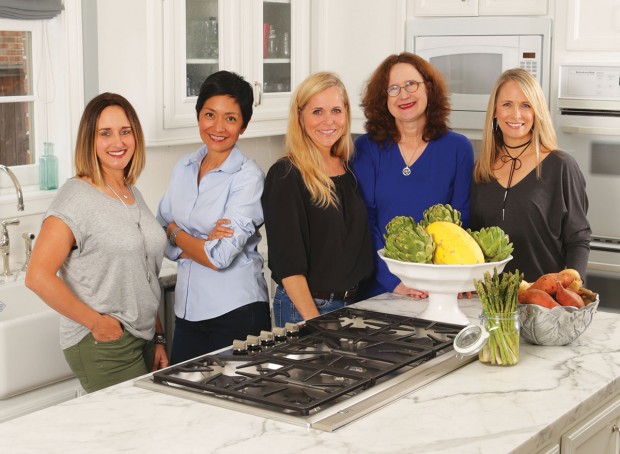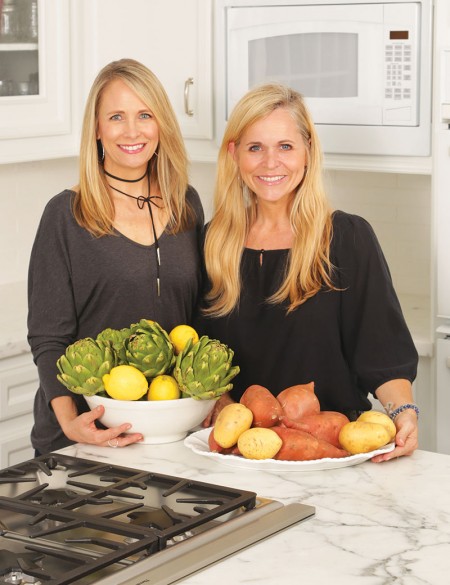The Whole Story
What is Whole30 anyway?


WHOLE GANG Whole30 buddies Lisa Glatstein, Kim Moore, Renae Nunez, Barbara Shreffler and Mary Schneidau(from left) supported each other in a Facebook group while eliminating dairy, grains, alcohol, legumes, sugar and anything processed from their diets. (Photo: lawellphoto.com)
February 28. Fat Tuesday. I had just finished off the last of a Gambino’s cream cheese king cake and sat down on the sofa, scrolling through Facebook and trying to feel better in spite of the cake, gin and fried oysters I’d ingested at Mardi Gras the previous weekend.
So it was fate that the first post I saw was from my perpetually cheerful friend Mary Schneidau. “My diet the last few days has been mainly fried food, vodka and king cake,” she wrote. “Has anyone else over-indulged this Mardi Gras? [Are you] interested in starting the ‘Whole30’ program with me tomorrow? C’mon, think of how good we will feel! Message me if interested.”
That was it. I had no idea what Whole30 was, but if it was going to make me feel better and wean me off king cake, I was in.
A quick Google later, I learned that Whole30 lies somewhere between a diet, a lifestyle change, a challenge and a cult. I couldn’t get through the hundreds of pages of “official” Whole30 information and advice from people who had done it. For 30 days, these people, who seemed to be everywhere, quit processed foods, including anything dairy, grain, alcohol, legume (all manner of beans) and sugar (real and fake). Pretty much everything except protein, veggies and fruit, staples being eggs, sweet potatoes, avocado, lean meat. No substitutions. Oh my.
Next day Mary added me and maybe 20 others – most of whom were strangers to each other and also happened to be Buzz readers – to a secret Facebook group she named “Yes We Can Do the Whole30!” Starting then, Mary became our improbable group’s Whole30 guru and cheerleader, posting and inspiring others to post tips, recipes, rules and motivation.
“I had always been plagued with migraines, and they went away,” Mary, mother of two teenagers, says of the first time she did Whole30 in 2013, prompted in the same way by a friend on Facebook. “Not only that, but once I had changed the way I ate, it was easy to stick to.”
The Whole30 website says it’s “designed to change your life in 30 days,” touting benefits too many to list, but including more energy, better sleep, clearer skin, improved GI issues and decreased pain. Even whiter eyes and fresher breath. Really?
According to Mary, yes. “The only reason I do it is because it makes me feel fantastic,” Mary says. “It’s not a scary diet like eating cabbage soup all day. Just healthy eating, and you only do the elimination part until you figure out how you react to certain foods.”

CHEERLEADER Mary Schneidau (at left) organized a Facebook group of friends sticking to a Whole30 diet. Renae Nunez (at right) was one of many encouraged by Mary. (Photo: lawellphoto.com)
After the 30 days, if you’re truly following the Whole30, you integrate food groups back into your diet, one at a time, being mindful of how each affects the way you feel physically and mentally. The idea is to target any foods that make you feel less than optimal, and either permanently eliminate or significantly reduce their presence in your daily diet. Weight loss is merely a side effect, says sports nutritionist (and now-author) Melissa Hartwig, who co-founded the program in 2009 after blogging about her own 30-day “life-changing” clean-eating experiment. No weigh-ins and no calorie counting allowed.
After completing an initial 30 days of virtue, Mary says, “For a couple of years, I kind of stayed on 80 percent of the time, but for the other 20 percent could have my tacos and margaritas that I loved so dearly. But this past year I had all this false confidence, and I went back to my old ways. And the horrible migraines.”
Barbara Shreffler, a fundraiser at Texas Children’s Hospital and violinist with the Houston Ballet, was suffering allergic reactions to something just about the time Mary floated that first post. “If Mary says there’s something to do, I never regret joining her,” she says. “I didn’t know what this thing was, but I said, ‘Yes!’ Although after [changing our diets], my husband says I have to run these things by him first.”
Even so, Barbara says she’s grateful to Mary. “Something was up, but I thought, ‘Maybe at 58 you metabolize differently.’ But I didn’t want to just give up and say that’s just how it’s going to be. Once I fundamentally changed some things, my skin’s improved, my hair is better, my gut is better – what’s not to like? Well, no wine. But at least now I find I’m completely satisfied with one glass.
“Also my coffee ritual,” Barbara says. “It’s very important to me, and I was bummed about losing dairy. I was the one shopping at Whole Foods wondering, ‘What the hell is paleo?’ Mary made the suggestion [on the Facebook page] to try coconut milk and cocoa powder in my coffee. It was actually delicious. I thought after 30 days I’d go back [to dairy], but I just don’t like it as much. Now, I’m not going to turn down a Starbucks at a meeting, but at home, this is really good.”
Barbara did have one fallback. “In my third week – a week out from finishing! – I just wanted a piece of wheat toast so badly, and I wanted it now. And it was a glorious piece of wheat bread. I didn’t put anything sweet or peanut butter on it. No, I put almond butter and dried fruit [both of which are compliant with the Whole30 plan; peanut butter and jelly are not]. So it was only a half-ass fail.”
Lisa Glatstein, another member of Mary’s group and a physical therapist, says, “My back was hurting so much that I ended up switching jobs, taking time to rest and decreasing my activity level. I was taking a lot of Advil just to go to work and play golf with my husband,” she says.
“That’s when Mary initiated this group. By the third week [of being on Whole30], I realized I wasn’t taking Advil. I still feel some stiffness, but it went away by 80 percent.”
Lisa’s biggest challenge was giving up Diet Coke. “You’ll see me complaining about it on Facebook,” she says. “But now I’m convinced that I was sensitive to fake sugar. I ate a lot of it in the name of dieting – protein bars, protein shakes, Skinny Cow ice creams, Diet Coke. Which kept me wanting sweet things.
“There are still days when it would be nice to sit with a magazine and a Diet Coke. But I know I don’t want that pain to come back. I don’t think you realize how bad you feel until you don’t feel bad.”
Even with glowing reports from the “Yes We Can!” group and their compassion for fails and cravings, not everyone sings as much success. Officially, Whole30 promotes a strict no-cheating policy that calls for a total re-start from Day 1 if a mere drop of alcohol or dab of cream should cross your lips – even if it’s on Day 29. Some say the plan sets participants up for failure. Almost as many “Whole30 failure” entries exist on Google as do success stories – many with read-me headings like, “Screw the Whole30,” or, “I did the Whole 3.”
A 46-year-old lawyer who had been Whole30-ing for a few months at the time of this writing says he’s been “unsatisfied with the food and bored.” The good side: “After two years of having a screwed-up trigger finger, it’s back to normal. Got a really painful steroid shot that wore off about a year ago. Has to be the diet. Very weird.” And then he adds: “I want a cupcake.”
There are other 30-day clean-eating plans out there, like Clean Food Crush and The Paleo Secret, all a little different but with the same premise: clean up your diet, kick sugar, feel better. Megan Schwartz, a registered licensed dietitian and owner of Kids Nutrition Houston, says they’re all basically good for you. “It’s good to get away from processed foods,” she says. “But if you just do it for 30 days, it will only work then. So I like that they offer a way to work back into your life without being so strict. The drawbacks can also be benefits. Doing [Whole30] requires a lot of cooking and prep. You have to really plan when going to the store, which is one of the hardest things, even though it’s a good habit.”
As for my own experience on Whole30, which has now turned into Whole90-something, I can say this: Day 25-ish I sunk into a depression when I realized I had been eating everything clean for a month and had lost zero pounds. Even with clearer skin (yes, it happened), sounder sleep (I’m now the person who wakes before my 5:30 a.m. alarm), more focus (I get in a serious zone) and amazing energy (I keep describing Whole30 as natural ADHD-med Vyvanse), I couldn’t shake my addiction to weight loss. But by week 7-and-a-half, with 7 pounds gone, I had drunk the Kool-Aid.
The thing is, though, life is short. Doughnuts are good. And when I asked Mary why she didn’t stick to Whole30 all the time, she quickly said, “Because fried food, vodka and king cake!” Amen.
Want more buzz like this? Sign up for our Morning Buzz emails.
To leave a comment, please log in or create an account with The Buzz Magazines, Disqus, Facebook, or Twitter. Or you may post as a guest.


